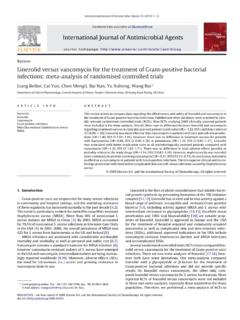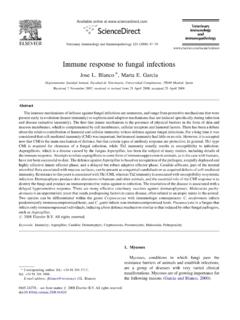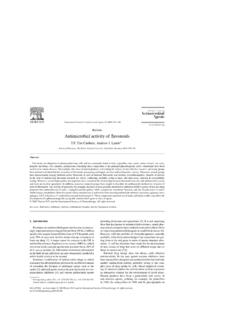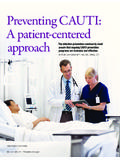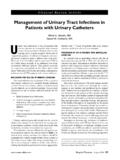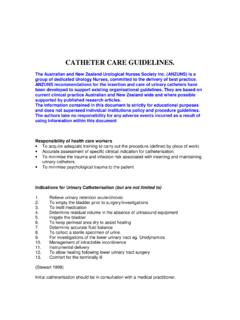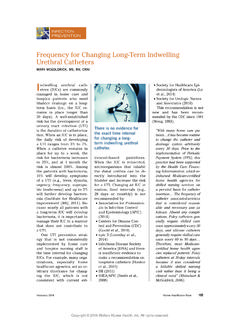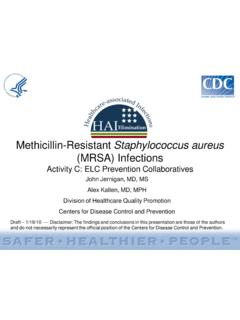Transcription of Urinary tract infections caused by Pseudomonas …
1 Journal of Infection and Public Health (2009)2, 101 111 REVIEWU rinary tract infections caused byPseudomonasaeruginosa: A minireviewRahul Mittala,b, , Sudhir Aggarwalc, Saroj Sharmab,Sanjay Chhibberb, Kusum HarjaibaDivision of Infectious Diseases, Childrens Hospital Los Angeles, Los Angeles, CA, USAbDepartment of Microbiology, Panjab University, Chandigarh, IndiacDepartment of Physiology, University of Tennessee Health Sciences Center, Memphis, TN, USAR eceived 1 July 2009; received in revised form 12 August 2009; accepted 13 August 2009 KEYWORDSU rinary tract infections ;Pseudomonasaeruginosa;Biofilm s;Virulence factorsSummaryUrinary tract infections (UTIs) are a serious health problem affectingmillions of people each year.
2 infections of the Urinary tract are the second mostcommon type of infection in the body. Catheterization of the Urinary tract is themost common factor, which predisposes the host to these infections . catheter -associated UTI (CAUTI) is responsible for 40% of nosocomial infections , making itthe most common cause of nosocomial infection. CAUTI accounts for more than 1million cases in hospitals and nursing homes annually and often involve uropathogensother thanEscherichia coli. While the epidemiology and pathogenic mechanisms ofuropathogenicEscherichia colihave been extensively studied, little is known aboutthe pathogenesis of UTIs caused by other organisms likePseudomonas available information regarding pathogenesis of UTIs caused byP.
3 Aerug-inosais an important bottleneck in developing effective preventive aim of this review is to summarize some of the advances made in the fieldofP. aeruginosainduced UTIs and draws attention of the workers that more basicresearch at the level of pathogenesis is needed so that novel strategies can bedesigned. 2009 King Saud Bin Abdulaziz University for Health Sciences. Published by ElsevierLtd. All rights factors of uropathogenicP. 102 Biofilm formation byP. 103 Quorum-sensing inP. 105 Corresponding author at: Division of Infectious Diseases, MS#51, Childrens Hospital Los Angeles, 4650 Sunset Boulevard,Los Angeles, CA, 90027, USA.
4 Tel.: +1 323 361 Mittal).1876-0341/$ see front matter 2009 King Saud Bin Abdulaziz University for Health Sciences. Published by Elsevier Ltd. All rights Mittal et factors and urovirulence ofP. 106 Tamm Horsfall 106 Host innate immune system and Urinary tract 106 Future 107 Conflict of 108 Urinary tract infections (UTIs) are one of themost common bacterial infections affecting humansthroughout their life span[1,2]. UTIs account formore than 8 million visits to physician s offices, million emergency room visits, and 300,000hospital admissions in the United States annually[3,4].
5 UTIs are the second most common infec-tion of any organ system and the most commonurological disease in the United States, with atotal annual cost of more than $ billion[5].These infections are more common in femalesthan in men. Incidence in women in the age of20 40 years ranges from 25 to 30% whereas inolder women above 60 years of age it rangesfrom 4 to 43%[6 8]. UTIs can be classified asuncomplicated or complicated[9,10]. The rec-ognized predisposing factors in complicated UTIsare anatomic defects, vesicouretic reflux (VUR),obstruction, surgery, metabolic diseases like dia-betes mellitus and generalized immunosuppressionespecially in patients of organ transplant[11 16].
6 Catheterization of Urinary tract is one of themost common factor which predisposes the host tocomplicated UTIs[17 20]. Instillation of cathetermay lead to damage of mucosal layer, whichdisrupts the natural barrier and allows bacte-rial colonization[21]. Organisms can gain entryvia extraluminal route[22]by moving acrossthe outer lumen of catheter or by intraluminalroute by directly entering the interior of catheter [23].The organisms most commonly responsible forcatheter-associated UTIs areEscherichia coli,Pro-teus mirabilis, Pseudomonas aeruginosa ,KlebsiellapneumoniaeandStrept ococcus faecalis[6,24 26].
7 In case ofE. coli, the epidemiological, experimen-tal and clinical studies have established the role ofmultiple virulence factors ofE. colilike adhesinsoperative through type-I fimbriae and P fim-briae, O serotypes, K1 capsule, serum resistance,hemolysins, cytotoxic nectrotizing factor (CNF) andsiderophores (enterochelin and aerobactin) in rela-tion to uncomplicated and complicated UTIs[2,27].However, there is paucity of literature in relationto pathogenesis of UTIs caused byP. advances in antimicrobial therapy, the mor-tality and morbidity associated withP.
8 Aeruginosainduced UTIs remain significantly high. This unfa-vorable outcome is due to our inability to developtherapeutic strategies to prevent the disease whichin turn is due to incomplete understanding aboutthe pathogenesis of the disease. The aim of thisreview is to highlight some of the most importantadvances in understanding the pathogenesis factors of aeruginosais the third most common pathogenassociated with hospital-acquired catheter -associated UTIs[6]. Virulence ofP. aeruginosaismultifactorial and has been attributed to cell-associated factors like alginate, lipopolysaccharide(LPS), flagellum, pilus and non-pilus adhesins aswell as with exoenzymes or secretory virulencefactors like protease, elastase, phopholipase,pyocyanin, exotoxin A, exoenzyme S, hemolysins(rhamnolipids) and siderophores[28 31].
9 Thesefactors have been shown to play an importantrole in pathogenesis ofP. aeruginosainducedinfections like respiratory tract infections , burnwound infections and keratitis[32 36]. However,limited reports are available regarding role of thesevirulence traits in Urinary tract infections . Woodset al.[36]showed high production of elastaseand protease in strains isolated from Urinary tractinfections in comparison to isolates from otherinfections like burn wounds infection, skin woundinfection and acute pneumonia. Quantitativeanalysis of elastase, phospholipase C, toxin A, andexoenzyme S was assessed inP.
10 Aeruginosastrainsisolated from wound infections , respiratory tractinfections and Urinary tract infections by Hamoodet al.[37]It was observed that most of the isolatesproduced all the four virulence traits. Howeverdepending on infection site, the isolates producedvaried levels of these virulence levels of elastase and phospholipase C wereUrinary tract infections caused byPseudomonas aeruginosa : A minireview103 Figure 1 Photograph showing complete encrustation of Urinary catheter by biofilms ofP. aeruginosa (A) and a highermagnification showing rod shaped bacteria on the surface of catheter (B).
